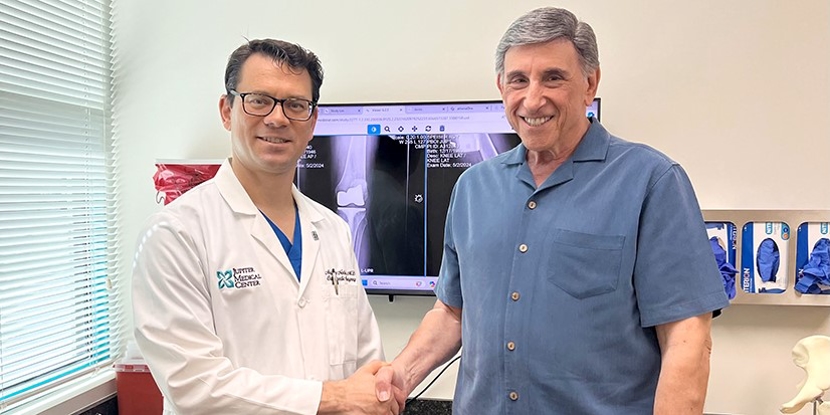Mako Technology Partial Knee
Mako Robotic-Arm Assisted Surgery Partial Knee Resurfacing and Replacement
.jpg) Mako Robotic-Arm Assisted Surgery is a treatment option for those living
with early to mid-stage osteoarthritis in either the medial (inner), patellofemoral
(top), or both compartments of the knee. If osteoarthritis (OA) is present
in all three compartments of the knee, it is considered advanced, and
you would not be a candidate for partial knee resurfacing.
Mako Robotic-Arm Assisted Surgery is a treatment option for those living
with early to mid-stage osteoarthritis in either the medial (inner), patellofemoral
(top), or both compartments of the knee. If osteoarthritis (OA) is present
in all three compartments of the knee, it is considered advanced, and
you would not be a candidate for partial knee resurfacing.
Mako is a robotic-assisted partial knee resurfacing procedure designed to relieve the pain caused by joint degeneration due to OA. By selectively targeting the part of your knee damaged by OA, your surgeon can resurface your knee while sparing the healthy bone and ligaments surrounding it.
A minimally invasive procedure, Mako Robotic-Arm Assisted Surgery can often be performed through a 4- to 6-inch incision over the knee with small incisions in both the femur (thighbone) and tibia (shin). Since healthy bone is preserved, patients who undergo Mako partial knee procedures may still be a candidate for a total knee replacement procedure later in life, if necessary.
The Mako procedure is indicated for patients suffering from unicompartmental or bicompartmental knee disease. A total replacement is sometimes necessary if your surgeon discovers during surgery that your knee has more damage than originally shown in the preoperative X-rays and CT scan.
If you are experiencing any of these, you may be a candidate for surgery:
- Knee pain with activity, usually on the inner knee and/or under the knee cap
- Start up knee pain or stiffness when activities are initiated from a sitting position
- Failure to respond to non-surgical treatments or nonsteroidal anti-inflammatory medication
Benefits of the Procedure:
- Improved surgical outcomes
- Less implant wear and loosening
- Joint resurfacing
- Bone sparing
- Smaller incision
- Less scarring
- Reduced blood loss
- Minimal hospitalization
- Rapid recovery
As a knee arthroplasty procedure, it is typically covered by Medicare. In some cases, it may be performed on an outpatient basis depending on what your Mako-certified surgeon determines is the right course of treatment for you. In many cases, patients are permitted to walk soon after surgery, drive a car in the first few weeks and return to normal daily activities shortly thereafter.
-
Jupiter Medical Center
We want to help you! If you have questions about our services and what we can offer you and your loved ones, please reach out.
-
 Chadwick
Chadwick
Hampton, MDOrthopedic Surgery, Orthopedics - Shoulder, Elbow, Orthopedics - Sports Medicine, Orthopedics - Total Joint ReplacementView Profile -
 Andrew
Andrew
Noble, MDOrthopedic Surgery, Orthopedics - Total Joint ReplacementView Profile -
 Michael
Michael
Leighton, MDOrthopedic Surgery, Orthopedics - Shoulder, Elbow, Orthopedics - Sports Medicine, Orthopedics - Total Joint ReplacementView Profile -
 Richard
Richard
Gorman, MD,FAAOSOrthopedic Surgery, Orthopedics - Sports Medicine, Orthopedics - Total Joint ReplacementView Profile -
 Michael
Michael
Cooney, MDOrthopedic Surgery, Orthopedics - Shoulder, Elbow, Orthopedics - Sports Medicine, Orthopedics - Total Joint ReplacementView Profile -
 Andrew
Andrew
A Seltzer, DOOrthopedic Surgery, Orthopedics - Hand, Wrist, Orthopedics - Total Joint ReplacementView Profile -
 Gary
Gary
Ackerman, MDOrthopedic Surgery, Orthopedics - Shoulder, Elbow, Orthopedics - Sports Medicine, Orthopedics - Total Joint ReplacementView Profile -
 David
David
Rondon, MDOrthopedic Surgery, Orthopedics - Foot, Ankle, Orthopedics - Shoulder, Elbow, Orthopedics - Total Joint Replacement, Pediatric Orthopedic SurgeryView Profile -
 Gavin
Gavin
Hart, MDOrthopedic Surgery, Orthopedics - Total Joint ReplacementView Profile -
 Lyall
Lyall
J Ashberg, MDOrthopedic Surgery, Orthopedics - Total Joint Replacement, Pediatric Orthopedic SurgeryView Profile








.png)



.jpg)

